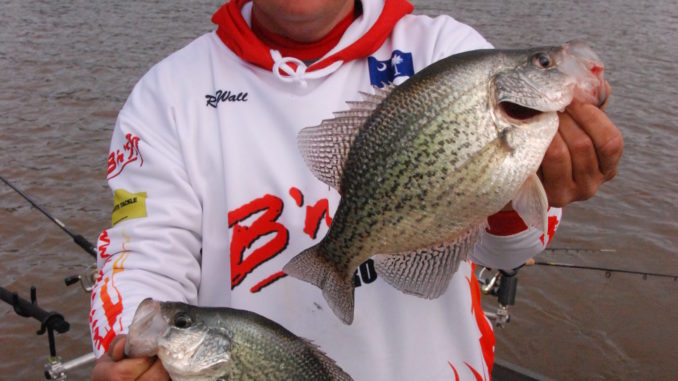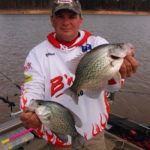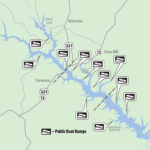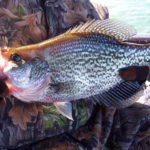
Stained water means suspended crappie, which means great trolling on Lake Greenwood.
Despite some occasional cold and rainy weather, March ushers in the spawning ritual for crappie on Lake Greenwood, and Rod Wall of Ninety Six can think of no better place to spend the month.
The combination of rising water temperatures, crappie that are suspending and good water color is what Wall, a tournament fisherman and former guide, loves to see — not only on the day of competition, but for the remainder of the spring.
“Long-line trolling is a very popular tactic on Lake Greenwood, and now with the water having some color to it, the crappie are starting to suspend,” said Wall. “That puts them right in the crosshairs for anglers who long-line troll for crappie. I believe Lake Greenwood is finally going to get the recognition it deserves as one of the best crappie lakes in the state.”
Unlike other reservoirs, Greenwood doesn’t have areas that are tremendously productive or rarely productive, as recent angler and creel surveys show a pretty even distribution of crappie across the 11,400-acre lake. Wall begins targeting crappie in deeper water and moves shallow, bearing in mind that suspended fish aren’t real particular about how much water is under them.
“Some of the deeper creeks like Cane Creek and the mouth of the Reedy River ,and even the smaller creeks down the lake — those with deeper water, 20-foot-plus depths, and mile-long runs — will be producing fish now towards the mouth of the creek,” said Wall. “But these fish are staging and are in pre-spawn mode, so look for them to be moving on into the creeks as the sunlight starts warming the water. Most of the better fish will be caught 10 to 14 feet deep in anywhere from 12 to 40 feet of water. You might see all kinds of fish all over the graph this, but most of the crappie seem to be suspending in that 10- to 14-foot range.”
At the end of February, Wall picks up on the crappie migration on the edge of the main channel of the Saluda River. As long as he can find stained water — with only a foot or so of visibility — he will long-line troll to catch crappie. He’ll follow the migrations of fish as they enter the creeks and work toward the backs.
Wall fishes up to 14 rods from the stern of his boat, except in tournaments, which typically limit the rod count to eight per boat. He staggers rod lengths: 16-, 14- and 12-foot rods on the rear gunwale in one rack, and four 9-foot rods in another rack mounted to each side of the transom. He fishes B’n’M spinning rods with reels spooled with 4-pound monofilament. The spread is pretty dramatic and he cuts a wide swathe of baits through the water.
“Depth of presentation is everything when crappie fishing,” he said. “Crappie feed up, but with murky water, which you need so they’ll suspend, they can only see a foot or two. Even with all these baits, it’s still a pretty narrow strike zone, and you’ve got to be dialed in to get bites.”
“Dialed in” means factoring in the weight of the jigs you’re using, boat speed, the amount of line you have out and line diameter. This combination will determine the all-important depth at which baits are running, and Wall doesn’t leave depth to chance. While he’s trolling, he intently watches his depth finder and makes note of baitfish, crappie and other species that may be mixed in. For anglers not accustomed to such exacting factors, he has designed a couple of cheat codes that will help them catch fish with the tactic.
“If you just want to catch some crappie, tie on any color 1/16-ounce jigs, throw them out 40 to 50 feet on 4-pound test, keep the trolling motor between .8 and 1.1 mph and run zig-zags across the channel,” he said. “Running zig-zags will cause the outside baits to rise and the inside baits to drop. Pay attention when you get a pull back on which rod. That will let you know if you need to be deeper or shallower. Also pay attention to what contours you were over — a flat, an edge, a ditch — and go find other contours at that depth, and you’ll find more fish.”
Another cheat code is to set the boat speed as a constant. He uses .9 mph as an example. The line size and amount of line out are also constant. In order to determine the proper depth at which to pull jigs, start with the heaviest on the rod on the transom that’s closest to the motor and graduate out to a tiny, 1/64-ounce jig on the 16-foot outrigger rod on the ends.
“I use a variation of this even when I know which jig weight to use,” said Wall. “Often, the passing of the boat overhead will push some crappie deeper and push some out shallow to the side of the boat. It also covers fish that are sunning in only a foot of water and don’t show up on the sonar.”
DESTINATION INFORMATION
HOW TO GET THERE/WHEN TO GO — Lake Greenwood lies in Greenwood, Laurens and Newberry counties at about the midway point between the headwaters and mouth of the Saluda River. The lake is owned by Greenwood County, which maintains several public ramps in each county. In addition, a number of private, pay-to-launch areas exist around the lake. Public access sites can be found on the SCDNR website at www.dnr.sc.gov/mlands/boatramp/. Crappie fishing begins to pick up in late February as fish stir from their winterhaunts along the main channel and move to the mouth of creeks and then to the back of the creeks. Great action can be had through April.
TACTICS — Crappie will move to the prespawn mode once water temperature get to 50 degrees and above. Fishermen may have more success in clear water using tight-line methods because crappie will be closer to the bottom and holding tighter to cover. In typically stained water, however, fish will suspend in the water column, making them easier targets for fishermen using long-line trolling tactics. Fishermen who choose not to troll can also catch fish by using single-ole jigging tactics around any of the bridges that cross the lake as fish move to the shallows as the water warms. Two railroad trestles that cross the lake — one just upstream of the US 221 bridge and one several miles downstream that also crosses Cane Creek, can be especially good.
FISHING INFO/GUIDES — Charlie’s B’s Citgo, 2120 Highway 246 S, Greenwood, 864-543-4828; Crenshaw’s Store, 6532 U.S. 221, Laurens, 864-682-2541; 702 Bait & Tackle, 4306 S Carolina 702, Ninety Six, 864-543-1556. See also Guides and Charters in Classifieds.
ACCOMMODATIONS — Greenwood Regional Tourism and Visitor’s Bureau, 864-953-2465, www.greenwoodsc.goV.
MAPS — Navionics Electronic Charts, 6 Thatcher Lane, Wareham, MA 02571; Delorme South Carolina Atlas & Gazetteer, 800-561-5105, www.delorme.com; Kingfisher Maps, 800-326-0257, www.kfmaps.com.





Be the first to comment